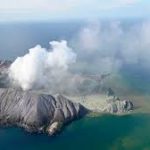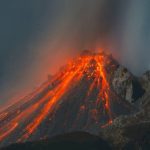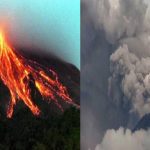Iceland has declared a state of emergency following thousands of earthquakes that sparked fears of a volcanic eruption.
Authorities have ordered thousands of people in the southwestern town of Grindavik to evacuate as a precaution, and the nearby Blue Lagoon tourist attraction has been closed.
For more than two weeks, the area around Mount Thorbjorn on the Reykjanes Peninsula has been shaken by hundreds of small earthquakes every day due to a buildup of volcanic magma – molten rock – around three miles (5km) underground.
Land in the region has risen by 9cm (3.5in) since the end of October, according to the Icelandic Met Office (IMO).
Scientists are closely monitoring the situation for any indication the seismic activity is getting closer to the surface.
Iceland, which sits above a volcanic hotspot in the North Atlantic, averages an eruption every four to five years.
The most disruptive in recent times was the 2010 eruption of the Eyjafjallajokull volcano, which spewed huge clouds of ash into the atmosphere and led to widespread airspace closures over Europe.
The Reykjanes Peninsula on Iceland’s southwest coast contains a dormant volcanic system that has erupted three times since 2021.
Grindavik was evacuated after the IMO warned that “significant changes in seismic activity” had occurred and that magma could have extended beneath the town, which is about 33 miles (53 kilometers) from the capital Reykjavik.
Iceland’s civil protection agency issued an order for residents to leave the area, but stressed that this was not an emergency evacuation.
Iceland has declared a state of emergency following thousands of earthquakes that sparked fears of a volcanic eruption.
Authorities have ordered thousands of people in the southwestern town of Grindavik to evacuate as a precaution, and the nearby Blue Lagoon tourist attraction has been closed.
For more than two weeks, the area around Mount Thorbjorn on the Reykjanes Peninsula has been shaken by hundreds of small earthquakes every day due to a buildup of volcanic magma – molten rock – around three miles (5km) underground.
Land in the region has risen by 9cm (3.5in) since the end of October, according to the Icelandic Met Office (IMO).
Scientists are closely monitoring the situation for any indication the seismic activity is getting closer to the surface.
Iceland, which sits above a volcanic hotspot in the North Atlantic, averages an eruption every four to five years.
The most disruptive in recent times was the 2010 eruption of the Eyjafjallajokull volcano, which spewed huge clouds of ash into the atmosphere and led to widespread airspace closures over Europe.
The Reykjanes Peninsula on Iceland’s southwest coast contains a dormant volcanic system that has erupted three times since 2021.
Grindavik was evacuated after the IMO warned that “significant changes in seismic activity” had occurred and that magma could have extended beneath the town, which is about 33 miles (53 kilometers) from the capital Reykjavik.
Iceland’s civil protection agency issued an order for residents to leave the area, but stressed that this was not an emergency evacuation.
Iceland has declared a state of emergency following thousands of earthquakes that sparked fears of a volcanic eruption.
Authorities have ordered thousands of people in the southwestern town of Grindavik to evacuate as a precaution, and the nearby Blue Lagoon tourist attraction has been closed.
For more than two weeks, the area around Mount Thorbjorn on the Reykjanes Peninsula has been shaken by hundreds of small earthquakes every day due to a buildup of volcanic magma – molten rock – around three miles (5km) underground.
Land in the region has risen by 9cm (3.5in) since the end of October, according to the Icelandic Met Office (IMO).
Scientists are closely monitoring the situation for any indication the seismic activity is getting closer to the surface.
Iceland, which sits above a volcanic hotspot in the North Atlantic, averages an eruption every four to five years.
The most disruptive in recent times was the 2010 eruption of the Eyjafjallajokull volcano, which spewed huge clouds of ash into the atmosphere and led to widespread airspace closures over Europe.
The Reykjanes Peninsula on Iceland’s southwest coast contains a dormant volcanic system that has erupted three times since 2021.
Grindavik was evacuated after the IMO warned that “significant changes in seismic activity” had occurred and that magma could have extended beneath the town, which is about 33 miles (53 kilometers) from the capital Reykjavik.
Iceland’s civil protection agency issued an order for residents to leave the area, but stressed that this was not an emergency evacuation.
Iceland has declared a state of emergency following thousands of earthquakes that sparked fears of a volcanic eruption.
Authorities have ordered thousands of people in the southwestern town of Grindavik to evacuate as a precaution, and the nearby Blue Lagoon tourist attraction has been closed.
For more than two weeks, the area around Mount Thorbjorn on the Reykjanes Peninsula has been shaken by hundreds of small earthquakes every day due to a buildup of volcanic magma – molten rock – around three miles (5km) underground.
Land in the region has risen by 9cm (3.5in) since the end of October, according to the Icelandic Met Office (IMO).
Scientists are closely monitoring the situation for any indication the seismic activity is getting closer to the surface.
Iceland, which sits above a volcanic hotspot in the North Atlantic, averages an eruption every four to five years.
The most disruptive in recent times was the 2010 eruption of the Eyjafjallajokull volcano, which spewed huge clouds of ash into the atmosphere and led to widespread airspace closures over Europe.
The Reykjanes Peninsula on Iceland’s southwest coast contains a dormant volcanic system that has erupted three times since 2021.
Grindavik was evacuated after the IMO warned that “significant changes in seismic activity” had occurred and that magma could have extended beneath the town, which is about 33 miles (53 kilometers) from the capital Reykjavik.
Iceland’s civil protection agency issued an order for residents to leave the area, but stressed that this was not an emergency evacuation.
Iceland has declared a state of emergency following thousands of earthquakes that sparked fears of a volcanic eruption.
Authorities have ordered thousands of people in the southwestern town of Grindavik to evacuate as a precaution, and the nearby Blue Lagoon tourist attraction has been closed.
For more than two weeks, the area around Mount Thorbjorn on the Reykjanes Peninsula has been shaken by hundreds of small earthquakes every day due to a buildup of volcanic magma – molten rock – around three miles (5km) underground.
Land in the region has risen by 9cm (3.5in) since the end of October, according to the Icelandic Met Office (IMO).
Scientists are closely monitoring the situation for any indication the seismic activity is getting closer to the surface.
Iceland, which sits above a volcanic hotspot in the North Atlantic, averages an eruption every four to five years.
The most disruptive in recent times was the 2010 eruption of the Eyjafjallajokull volcano, which spewed huge clouds of ash into the atmosphere and led to widespread airspace closures over Europe.
The Reykjanes Peninsula on Iceland’s southwest coast contains a dormant volcanic system that has erupted three times since 2021.
Grindavik was evacuated after the IMO warned that “significant changes in seismic activity” had occurred and that magma could have extended beneath the town, which is about 33 miles (53 kilometers) from the capital Reykjavik.
Iceland’s civil protection agency issued an order for residents to leave the area, but stressed that this was not an emergency evacuation.
Iceland has declared a state of emergency following thousands of earthquakes that sparked fears of a volcanic eruption.
Authorities have ordered thousands of people in the southwestern town of Grindavik to evacuate as a precaution, and the nearby Blue Lagoon tourist attraction has been closed.
For more than two weeks, the area around Mount Thorbjorn on the Reykjanes Peninsula has been shaken by hundreds of small earthquakes every day due to a buildup of volcanic magma – molten rock – around three miles (5km) underground.
Land in the region has risen by 9cm (3.5in) since the end of October, according to the Icelandic Met Office (IMO).
Scientists are closely monitoring the situation for any indication the seismic activity is getting closer to the surface.
Iceland, which sits above a volcanic hotspot in the North Atlantic, averages an eruption every four to five years.
The most disruptive in recent times was the 2010 eruption of the Eyjafjallajokull volcano, which spewed huge clouds of ash into the atmosphere and led to widespread airspace closures over Europe.
The Reykjanes Peninsula on Iceland’s southwest coast contains a dormant volcanic system that has erupted three times since 2021.
Grindavik was evacuated after the IMO warned that “significant changes in seismic activity” had occurred and that magma could have extended beneath the town, which is about 33 miles (53 kilometers) from the capital Reykjavik.
Iceland’s civil protection agency issued an order for residents to leave the area, but stressed that this was not an emergency evacuation.
Iceland has declared a state of emergency following thousands of earthquakes that sparked fears of a volcanic eruption.
Authorities have ordered thousands of people in the southwestern town of Grindavik to evacuate as a precaution, and the nearby Blue Lagoon tourist attraction has been closed.
For more than two weeks, the area around Mount Thorbjorn on the Reykjanes Peninsula has been shaken by hundreds of small earthquakes every day due to a buildup of volcanic magma – molten rock – around three miles (5km) underground.
Land in the region has risen by 9cm (3.5in) since the end of October, according to the Icelandic Met Office (IMO).
Scientists are closely monitoring the situation for any indication the seismic activity is getting closer to the surface.
Iceland, which sits above a volcanic hotspot in the North Atlantic, averages an eruption every four to five years.
The most disruptive in recent times was the 2010 eruption of the Eyjafjallajokull volcano, which spewed huge clouds of ash into the atmosphere and led to widespread airspace closures over Europe.
The Reykjanes Peninsula on Iceland’s southwest coast contains a dormant volcanic system that has erupted three times since 2021.
Grindavik was evacuated after the IMO warned that “significant changes in seismic activity” had occurred and that magma could have extended beneath the town, which is about 33 miles (53 kilometers) from the capital Reykjavik.
Iceland’s civil protection agency issued an order for residents to leave the area, but stressed that this was not an emergency evacuation.
Iceland has declared a state of emergency following thousands of earthquakes that sparked fears of a volcanic eruption.
Authorities have ordered thousands of people in the southwestern town of Grindavik to evacuate as a precaution, and the nearby Blue Lagoon tourist attraction has been closed.
For more than two weeks, the area around Mount Thorbjorn on the Reykjanes Peninsula has been shaken by hundreds of small earthquakes every day due to a buildup of volcanic magma – molten rock – around three miles (5km) underground.
Land in the region has risen by 9cm (3.5in) since the end of October, according to the Icelandic Met Office (IMO).
Scientists are closely monitoring the situation for any indication the seismic activity is getting closer to the surface.
Iceland, which sits above a volcanic hotspot in the North Atlantic, averages an eruption every four to five years.
The most disruptive in recent times was the 2010 eruption of the Eyjafjallajokull volcano, which spewed huge clouds of ash into the atmosphere and led to widespread airspace closures over Europe.
The Reykjanes Peninsula on Iceland’s southwest coast contains a dormant volcanic system that has erupted three times since 2021.
Grindavik was evacuated after the IMO warned that “significant changes in seismic activity” had occurred and that magma could have extended beneath the town, which is about 33 miles (53 kilometers) from the capital Reykjavik.
Iceland’s civil protection agency issued an order for residents to leave the area, but stressed that this was not an emergency evacuation.














